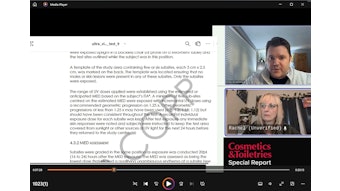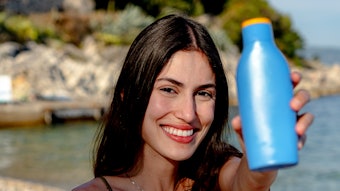So far, 2012 has been a busy year for cosmetic ingredient regulations. On February 29, the ECHA released its list of the first 90 ingredients to be evaluated under REACH. Included were cosmetic ingredients as well as starting materials for other ingredients. Those used by the personal care industry are listed in Table 1 (in the full article), along with the concerns for each. Considering this list, the European personal care industry is in trouble if these ingredients are restricted or even worse, phased out because the manufacturing of them as well as products containing them would be forced out of the EU. Also considering the current economic environment, this is not a good political move since cosmetic companies and chemical suppliers are already under pressure from foreign imports, and this would be another reason to move everything offshore, which would destroy local manufacturing bases and related jobs.
Starting ingredients—methanol: First, consider the impact of potential restrictions on starting ingredients. Methanol is rarely used as a denaturant in alcohol and it is prohibited in Japan, so limiting it as a cosmetic ingredient will not concern the industry. However, methanol is the preferred solvent to separate unsaturated fatty acids from saturated fatty acids. So if there are users of this starting material in the EU, they might be compelled, like their competitors, to move operations to Southeast Asia. Another major use of methanol is to transesterify coconut oil to methyl cocoate, which is the major starting material for producing coco-based amides. Methyl cocoate can be fractionally distilled to form the pure methyl esters of C6 to C18 fatty acids.
Of importance to personal care is the fact that methyl laurate is used to make lauramides, methyl myristate is used to produce isopropyl myrsitate, and methyl palmitate is used to make retinyl palmitate. Finally, the methyl esters of coconut oil can be hydrogenated to form the so-called natural fatty alcohols, which find use both as cosmetic ingredients and as starting materials for many emollients, surfactants and emulsifiers. If they cannot be produced in the EU, they must be produced elsewhere.
Starting ingredients—ethylene oxide: Ethylene oxide is the starting material for phenoxyethanol, ethoxylated fatty alcohols, fatty acids, polyethylene glycols, alkanolamines …the list goes on. It is also the primary material used to increase the water solubility of oil-soluble chemicals. Although it is hazardous to handle and very toxic, manufacturers and users are well aware of how to manage its use, and accidents are few and far between.
Starting ingredients—ethanolamines: Monoethanolamine (MEA), diethanolamine (DEA) and triethanolamine (TEA) are included in the list, and they are all produced by reacting ethylene oxide with ammonia. These materials are used to neutralize fatty acids to form soap emulsifiers in situ, and also to neutralize hair spray resins to adjust their holding power. In addition, they are the starting materials for amides, popular thickening and foam stabilizing agents, shampoos, liquid soaps, cleansing gels, etc.
Cosmetic ingredients—titanium dioxide: In addition to starting materials, several cosmetic ingredients are listed by the ECHA, beginning with titanium dioxide. Frequency of use reports show this is the one of the most commonly used ingredients in cosmetics, surpassed only by water, fragrance, parabens, glycerin and propylene glycol. It is used in all types of makeup, is added to creams and lotions to increase their white appearance, and is a popular UV filter worldwide. However, the personal care industry’s use of titanium dioxide pales in comparison with the paint and paper industry’s use. Everything that appears white most likely contains titanium dioxide—from printer paper and computer keys, to drywall, appliances, pills, foods and plastics.
Cosmetic ingredients—octocrylene and octinoxate: Octocrylene and octinoxate (INCI: Ethylhexyl Methoxycinnamate) are two popular UV filters. Of course they can be produced outside of the EU, as they are. And the EU has many more UV filters to work with than the United States but this could end their production in the EU, which is not bad news for the United States; it means more exports.
Cosmetic ingredients—triclosan: In this author’s opinion, triclosan is probably the most vilified ingredient, surpassing parabens and formaldehyde. Its use in the United States is mostly in over-the-counter drugs such as antibacterial cleansers but in the EU it is regulated as a cosmetic. With nongovernmental organizations constantly attacking it, however, political pressure to prohibit it is rising worldwide. Cosmetic ingredients—butylphenyl methylpropional: Butylphenyl methylpropional is a popular chemical used as a fragrance in perfumes but as its popularity has grown, so have allergic reactions.
Comments
While the release of this chemical list is clearly the “ugly” news of the year thus far, it does not necessarily mean anything will come of it. The REACH process is a long one, and many reports are not due until 2014. One can hope that common sense and good science will prevail over the demands for 100% safety, also known as the precautionary principle—after all, everything is hazardous under certain conditions; 5 g of water can drown an individual but water is also crucial to survival. But under the precautionary principle, its use would be banned or restricted.
The Good
The Personal Care Products Council’s International Nomenclature Cosmetic Ingredient (INCI) Dictionary defines cyclomethicone as “a generic name for cyclic dimethyl polysiloxane compounds that conform to the formula where n has a value between 4 and 6. The INCI names for labeling specific cyclic dimethyl polysiloxane compounds are: Cyclotetrasiloxane (also called D4), when n is equal to 4; Cyclopentasiloxane (D5), when n is equal to 5; and Cyclohexasiloxane (D6), when n is equal to 6.” The use of these products is as transient emollients. They have a pleasing skin feel and evaporate at body temperature.
D4 or cyclotetrasiloxane: Environment Canada released its findings on D4 in November of 2008, stating, “The government of Canada has determined that D4 is harmful to the environment but is not harmful to human health.” Based on this conclusion, it also found that octamethylcyclotetrasiloxane (D4) meets the definition of toxic as set out in paragraph 64a of the Canadian Environmental Protection Act (CEPA) of 1999 and meets the criteria for persistence as set out in the Persistence and Bioaccumulation regulations; however, the group found it “not possible to conclude that octamethylcyclotetrasiloxane meets the criterion for bioaccumulation, considering the conflicting evidence presented in this screening assessment report.” CEPA’s conclusion that D4 is toxic led to the discontinuation of its use in cosmetics in Canada, and at some point in the future, Health Canada plans to add D4 to its “hot list.”
When CEPA originally announced its conclusions for D4 and other chemicals such as lead, mercury, asbestos, etc., its findings were reported on the evening news and panic broke out in Ottawa the next day. Women returned baby bottles to local stores and demanded their money back. Why? Because one of the monomers used to make the polymer in the bottles is Bis Phenol-A (BPA), which was declared as CEPA toxic. How bad was this? Days later, in the United States, New Jersey newspaper headlines reported that Environment Canada found baby bottles to be toxic. What a total misinterpretation of the facts.
D5 or cyclopentasiloxane: Environment Canada also published its findings on D5 in November 2008, stating, “D5 is harmful to the environment but is not harmful to human health.” However, industry members worked together under the Canadian Cosmetic, Toiletry and Fragrance Association’s (CCTFA’s) leadership to reverse this ruling. Following the publication of this November 2008 announcement, a formal Notice of Objection requesting the establishment of a Board of Review was filed by the Silicones Environmental, Health and Safety Council (SEHSC) of North America in July 2009. The SEHSC submitted information regarding the toxicity of D5, which the Minister of the Environment considered, and on August 21, 2010, a Board of Review was established to inquire into the nature and extent of the danger posed by D5 to the Canadian environment or its biological diversity.
This was the first time since Environmental Canada began reviewing chemicals that a request like this was granted. On Oct. 20, 2011, after consideration of the properties of D5 and the available scientific information, the board completed its report finding that D5 did not pose a danger to the environment. Finally, on Feb. 25, 2012, after considering all available information including the board’s report and recommendations, the Canadian government published its revised decision on D5, stating that: “D5 is not entering the environment in a quantity or under conditions that constitute a danger to the environment.” These results were published in the Canada Gazette Part I. View the notice.
D6 or cyclohexasiloxane: D6 was never in danger of restriction. Comments The critical battle to save D5 was won but the war continues. The work of the SECHS with the CCTFA was an outstanding example of science triumphing over bad data. However, this battle has now shifted to the EU, where the UK leads the charge in assessing D4 and D5 under REACH. The data submitted to Environment Canada is being used to defend these important ingredients, especially D5.
The EU Scientific Committee on Consumer Safety (SCCS) issued its opinion on June 22, 2010, stating that: “Cyclomethicone (D4, D5) does not pose a risk for human health when used in cosmetic products. Other uses were not considered in this risk assessment. It should be noted that D4 is classified as a reprotoxic substance, category 3 [ECB 2006].” The SCCS continued, “The ‘no observable adverse effect level’ (NOAEL) ruling for systemic toxicity used for this risk assessment (NOAEL = 150 ppm) also covers reprotoxic effects (NOAEL = 300 ppm). Environment Canada’s Commission Services should consider whether an environmental risk assessment associated with the use of cyclomethicone (D4/D5) in cosmetic products is required.” Of course, this battle to kill the use of cyclic silicones is aided by the cosmetic industry’s “silicone-free” label claims, while ingredient suppliers rush to offer substitutes.
The Bad
Finally, on Feb. 22, 2012, the state of California issued its intent to add three cosmetic ingredients to the Proposition 65 list of chemicals known to the state to cause cancer or reproductive toxicity. These include diethanolamine, cocamide DEA and benzephenone.
Diethanolamine: This ingredient is rarely used now, as it is prohibited in the EU.
Cocamide DEA: This ingredient is still a popular thickening agent and foam booster for shampoos, bubble baths, foaming gels, etc. The state of California describes it as the condensate obtained from the reaction of coconut oil and diethanolamine. If this were to be added to the Proposition 65 list, one wonders whether manufacturers could avoid cancer warnings on the label by listing individual amides rather than the coconut oil source, or by making cocamide DEA from methyl cocoate instead. Benzephenone: No, this ingredient is not benzophenone-3 (oxybenzone), which is used in sunscreens. It is a UV absorber mainly used in nail polishes. Adding benzephenone to the list will automatically trigger its required registration under the California Safe Cosmetic Act.
In addition, back in Canada, Health Canada has indicated at meetings that labeling an ingredient with the generic term cyclomethicone may trigger an independent analysis for D4. Even trace amounts will cause issues; however, if manufacturers label products with the correct INCI designations of cyclopentasiloxane and/or cyclohexasiloxane, then trace amounts of D4 will not be an issue.
The time has come to label products correctly.










